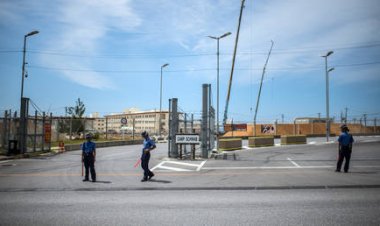Judge rejects QAnon shaman’s bid to throw out Jan. 6 sentence
The judge also castigated Tucker Carlson for airing misleading footage about the attack on the Capitol.


A federal judge has denied a bid by Jacob Chansley — the Jan. 6 rioter who famously wore a horned helmet and left a menacing note for Mike Pence on the Senate dais — to throw out his conviction by citing videos aired in February by then-Fox News host Tucker Carlson.
U.S. District Court Judge Royce Lamberth said the videos aired by Carlson, which showed Chansley roaming the halls of the Capitol, occasionally alongside outnumbered Capitol Police officers, were devoid of meaningful context, especially when contrasted with the extraordinary volume of evidence of Chansley’s crimes.
In fact, if Chansley, who pleaded guilty in September 2021 to obstructing Congress’ proceedings, were sentenced today, Lamberth wrote in a 35-page opinion on Thursday, he might be inclined to sentence him to a lengthier prison term than the 41 months he received.
“Without Mr. Chansley's apparently unequivocal acceptance of responsibility, the Court is confident that he would have received a higher sentence,” Lamberth wrote.
Chansley, who strode through the Capitol on Jan. 6 shirtless and carrying a spear-tipped flagpole, has been one of the most infamous members of the Jan. 6 mob. Known as the “QAnon shaman,” he surged into the building within moments of the first breach and joined a 30-minute standoff between rioters and Capitol Police outside the Senate chamber.
Chansley ignored repeated exhortations by officers to leave before he entered the Senate floor, strode onto the rostrum and said a prayer. He then scrawled a note to Pence, who had been standing on the same rostrum just minutes before: “It’s only a matter of time. Justice is coming!”
Chansley was one of the first prominent members of the mob arrested after Jan. 6 and was placed in pretrial detention. He was sentenced in November 2021 and was released earlier this year.
Speaker Kevin McCarthy granted Carlson exclusive access to Capitol security footage in January, shortly after Republicans took the House. After mining the thousands of hours of footage, he aired a few clips of never-before-seen videos of Chansley meandering through the halls, encountering officers who gave him little resistance.
Carlson didn’t air footage of Chansley getting into the Capitol or of the moments that featured prominently in his indictment and guilty plea.
Lamberth used his opinion to confront Carlson directly, calling his depiction of the Jan. 6 footage “ill-advised.”
“Not only was the broadcast replete with misstatements and misrepresentations regarding the events of January 6, 2021 too numerous to count, the host explicitly questioned the integrity of this Court — not to mention the legitimacy of the entire U.S. criminal justice system — with inflammatory characterizations of cherry-picked videos stripped of their proper context,” he wrote. “In so doing, he called on his followers to ‘reject the evidence of [their] eyes and ears,’ language resembling the destructive, misguided rhetoric that fueled the events of January 6 in the first place.”
“The Court finds it alarming that the host's viewers throughout the nation so readily heeded his command,” Lamberth added. “But this Court cannot and will not reject the evidence before it. Nor should the public.”
Lamberth said the newly aired footage added no significant new details to Chansley’s case, virtually all of which were known to Chansley and his attorney prior to his sentencing. In fact, the one clip that prosecutors turned over after Chansley’s sentencing — a 10-second video of Chansley walking near the Senate chamber — had no “exculpatory” value, Lamberth wrote.
“Mr. Chansley possessed the facts in the videos well in advance of his plea agreement, yet still determined, quite sensibly, to accept responsibility for his role in the criminal events of January 6, 2021,” Lamberth wrote. “What is more, the record shows that the government disclosed virtually all of the videos at issue weeks before Mr. Chansley' s sentencing. These facts and the underlying law conclusively demonstrate that Mr. Chansley is not entitled to relief.”
Lamberth noted that subsequent to Chansley’s sentencing, prosecutors had unearthed terabytes of new material, some of which might add to the aggravating factors in Chansley’s case. He noted that prosecutors, for example, might today be able to show Chansley was aware of the gallows erected outside the Capitol when he scrawled his note to Pence — a detail that might have counseled in favor of a lengthier sentence, rather than a shorter one.
Lamberth also expressed regret that Chansley appeared to have “recanted the contrition he displayed at his sentencing hearing nearly two years ago.” At the time, Lamberth appeared moved by Chansley’s effusive acceptance of responsibility and sentenced him to the lowest end of the recommended range.
“Such an about-face casts serious doubt on the veracity of any of Mr. Chansley' s claims, here or elsewhere,” Lamberth wrote in Thursday’s opinion.
Chansley's lawyer, William Shipley, said after the ruling that it is "always a challenge" to set aside a conviction or sentence, adding that "the relief available even if we prevailed was uncertain" because Chansley has already served his sentence.
"Our main goal was to simply force the government to explain why video evidence was not timely produced during a period defendants like Jake were being detained in custody," he added. "We still believe the government has not provided a sufficient justification in that regard."












